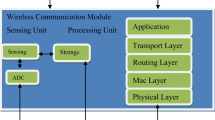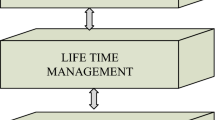Abstract
Nowadays, wireless sensor network (WSN) is an important component in IoT environment, which enables efficient data collection and transmission. Since WSN consists of a large number of sensor nodes, network congestion can easily occur which significantly degrades the performance of entire network. In this paper a novel scheme called SMQP (Statistical Multipath Queue-wise Preemption) routing is proposed to balance the load and avoid the congestion for ZigBee-based WSN. This is achieved by employing statistical path scheduling and queue-wise preemption with multiple paths between any source and destination node. NS2 simulation reveals that the proposed scheme significantly improves the QoS in terms of delivery ratio, end-to-end delay, and packet delivery ratio compared to the representative routing schemes for WSN such as ad hoc on-demand distance vector and ad hoc on-demand multipath distance vector scheme.









Similar content being viewed by others
References
Zigbee Alliance. (2017). Retrieved January 15, 2017 from http://www.zigbee.org/.
Jiantao, C., & Xiaojun, Z. (2016). Study of IoT terminal interface platform based on embedded technology and Zigbee protocol. International Journal of Future Generation Communication and Networking, 9(6), 55–64.
Al-Ghamdi, B., Ayaida, M., & Fouchal, H. (2015). Scheduling approaches for wireless sensor networks. In 2015 15th international conference on innovations for community services (I4CS) (pp. 1–6). IEEE.
Lou, W., Liu, W., & Zhang, Y. (2006). Performance optimization using multipath routing in mobile ad hoc and wireless sensor networks. In M. X. Cheng, Y. Li, & D. Z. Du (Eds.), Combinatorial optimization in communication networks (pp. 117–146). Boston: Springer.
Marina, M. K., & Das, S. R. (2001). On-demand multipath distance vector routing in ad hoc networks. In Ninth international conference on network protocols (pp. 14–23). IEEE.
Yuan, Y., Chen, H., & Jia, M. (2005). An optimized ad-hoc on-demand multipath distance vector (AOMDV) routing protocol. In 2005 Asia-Pacific conference on communications (pp. 569–573). IEEE.
Zhong, D., Ji, W., Liu, Y., Han, J., & Li, S. (2011). An improved routing algorithm of Zigbee wireless sensor network for smart home system. In 2011 5th international conference on automation, robotics and applications (ICARA) (pp. 346–350). IEEE.
Collotta, M., Scatà, G., & Pau, G. (2013). A priority-based CSMA/CA mechanism to support deadline-aware scheduling in home automation applications using IEEE 802.15.4. International Journal of Distributed Sensor Networks, 9, 139804.
Islam, N., Biddut, M. J. H., Swapna, A. I., & Jany, M. H. R. (2015). A study on priority based ZigBee network performance analysis with tree routing method. Journal of Computer and Communications, 3(08), 1.
Karim, L., Nasser, N., Taleb, T., & Alqallaf, A. (2012). An efficient priority packet scheduling algorithm for wireless sensor network. In 2012 IEEE international conference on communications (ICC) (pp. 334–338), IEEE.
Yu, X., Xiaosong, X., & Wenyong, W. (2009). Priority-based low-power task scheduling for wireless sensor network. In 2009 international symposium on autonomous decentralized systems.
Edalat, N., Xiao, W., Tham, C.-K., Keikha, E., & Ong, L.-L. (2009). A price-based adaptive task allocation for wireless sensor network. In IEEE 6th international conference on mobile adhoc and sensor systems, 2009. MASS’09 (pp. 888–893). IEEE.
Momeni, H., Sharifi, M., & Sedighian, S. (2009). A new approach to task allocation in wireless sensor actor networks. In First international conference on computational intelligence, communication systems and networks, 2009. CICSYN’09 (pp. 73–78). IEEE.
Tirkawi, F., & Fischer, S. (2008). Adaptive tasks balancing in wireless sensor networks. In 3rd international conference on information and communication technologies: From theory to applications, 2008. ICTTA 2008 (pp. 1–6), IEEE.
Zhao, Y., Wang, Q., Wang, W., Jiang, D., & Liu, Y. (2009). Research on the priority-based soft real-time task scheduling in TinyOS. In International conference on information technology and computer science, 2009. ITCS 2009 (Vol. 1, pp. 562–565). IEEE.
Christinal, B., & Vinodhini, V. (2014). An efficient multitask scheduling technique for the improvement of WSN with network lifetime & delay constraint. International Journal of Advanced Research in Computer Science, 5(6), 225–230.
Preemption and Context Switching | The Linux Process Scheduler | InformIT. (n.d.). Retrieved January 16, 2017 from http://www.informit.com/articles/article.aspx?p=101760&seqNum=3.
Preemption (computing). (2017). Retrieved January 5, 2017 from https://en.wikipedia.org/wiki/Preemption_(computing).
Kim, K.-I., Park, S., Park, H., & Ham, Y. H. (2008). Reliable and real-time data dissemination in wireless sensor networks. In Military communications conference, 2008. MILCOM 2008 (pp. 1–5). IEEE.
Lu, C., Blum, B. M., Abdelzaher, T. F., Stankovic, J. A., & He, T. (2002). Rap: A real-time communication architecture for large-scale wireless sensor networks. In Eighth IEEE real-time and embedded technology and applications symposium, 2002. Proceedings (pp. 55–66). IEEE.
Wang, C., Li, B., Sohraby, K., Daneshmand, M., & Hu, Y. (2007). Upstream congestion control in wireless sensor networks through cross-layer optimization. IEEE Journal on Selected Areas in Communications, 25(4), 786–795.
Mizanian, K., Hajisheykhi, R., Baharloo, M., & Jahangir, A. H. (2009). RACE: A real-time scheduling policy and communication architecture for large-scale wireless sensor networks. In Seventh annual communication networks and services research conference, 2009. CNSR’09 (pp. 458–460). IEEE.
Lin, K., Zhao, H., Yin, Z., & Bi, Y. (2007). An adaptive double ring scheduling strategy based on tinyos. Journal-Northeastern University Natural Science, 28(7), 985.
Lee, E.-M., Kashif, A., Lee, D.-H., Kim, I.-T., & Park, M.-S. (2010). Location based multi-queue scheduler in wireless sensor network. In 2010 the 12th international conference on advanced communication technology (ICACT) (Vol. 1, pp. 551–555). IEEE.
Karimi, E., & Akbari, B. (2011). Improving video delivery over wireless multimedia sensor networks based on queue priority scheduling. In 2011 7th international conference on wireless communications, networking and mobile computing (WiCOM) (pp. 1–4). IEEE.
Radi, M., Dezfouli, B., Bakar, K. A., & Lee, M. (2012). Multipath routing in wireless sensor networks: Survey and research challenges. Sensors, 12(1), 650–685.
Lafta, H. A., & Salman, F. M. (2014). Optimal path selection in ad hoc (MANET) by using genetic fuzzy petri net. Researcher, 6(8), 31–44.
Anon. (2003). Stochastic Modelling and Applied Probability. In Applied Probability and Queues. https://doi.org/10.1007/b97236.
Bakouch, H. S. (2011). Probability, Markov chains, queues, and simulation. Journal of Applied Statistics, 38(8), 1746. https://doi.org/10.1080/02664763.2010.484891.
Zheng, J., & Lee, M. J. (2006). A comprehensive performance study of IEEE 802.15. 4. In Sensor network operations (pp. 218–237). IEEE Press, Wiley Interscience.
NS2. (n.d.). Retrieved February 16, 2017 from http://www-ee.ccny.cuny.edu/zheng/pub.
Shreedhar, M., & Varghese, G. (1996). Efficient fair queuing using deficit round-robin. IEEE/ACM Transactions on Networking, 4(3), 375–385.
Acknowledgements
This work was partly supported by Institute for Information & communications Technology Promotion (IITP) grant funded by the Korea government (MSIT) (No. 2016-0-00133, Research on Edge computing via collective intelligence of hyperconnection IoT nodes), Korea, under the National Program for Excellence in SW supervised by the IITP (Institute for Information & communications Technology Promotion) (2015-0-00914), Basic Science Research Program through the National Research Foundation of Korea (NRF) funded by the Ministry of Education, Science and Technology (2016R1A6A3A11931385, Research of key technologies based on software defined wireless sensor network for realtime public safety service, 2017R1A2B2009095, Research on SDN-based WSN Supporting Real-time Stream Data Processing and Multiconnectivity), the second Brain Korea 21 PLUS project, and Samsung Electronics.
Author information
Authors and Affiliations
Corresponding author
Rights and permissions
About this article
Cite this article
Ullah, I., Youn, H.Y. Statistical Multipath Queue-Wise Preemption Routing for ZigBee-Based WSN. Wireless Pers Commun 100, 1537–1551 (2018). https://doi.org/10.1007/s11277-018-5652-2
Published:
Issue Date:
DOI: https://doi.org/10.1007/s11277-018-5652-2




